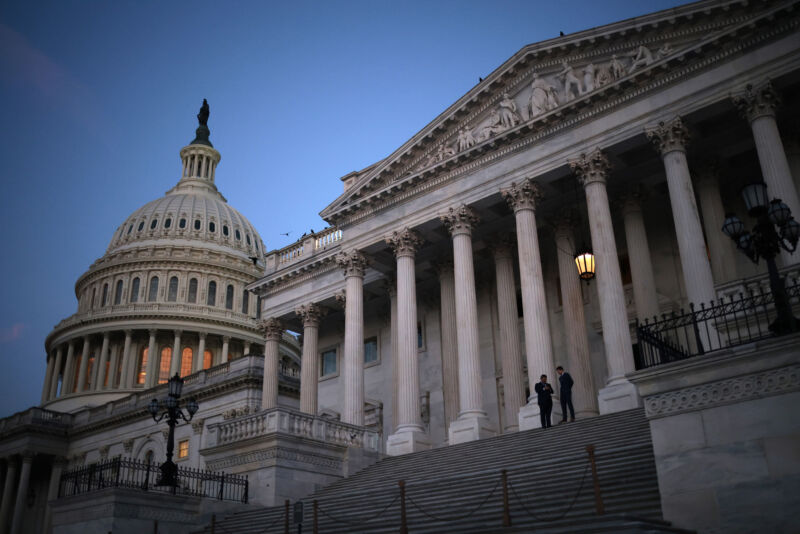Cheaper than the alternative —
From clean energy to EV chargers, wide-ranging bill would have lasting effects.
Tim De Chant
–

President Joe Biden’s climate ambitions will face a critical test on Monday as a major portion of the $3.5 trillion reconciliation bill comes up for a vote. If it passes, the sprawling legislation will push the American economy to rein in its carbon emissions by spurring advancements in clean energy, electric vehicles, grid modernization, and more.
Nearly $500 billion worth of grants, incentives, and programs will be voted on by the members of the House Energy and Commerce Committee. After that, the legislation will be merged with the other portions of the reconciliation bill as soon as Wednesday. Senate Democrats have been meeting to draft their version of the bill, and Congressional Democrats hope to send a finalized piece of legislation to Biden by the end of the year.
So far, Republicans are united in their opposition, and the reconciliation bill’s passage appears to hinge on whether Sen. Joe Manchin (D-W.Va.) approves of key portions. Manchin, who represents coal-rich West Virginia and who owns millions of dollars of stock in a coal brokerage, has expressed reservations about the bill eliminating fossil fuels.
Ultimately, Manchin may be persuaded to vote yea or nay by the United Mine Workers of America. Currently, the group is inclined to oppose the entire reconciliation bill because it doesn’t include provisions for retraining coal miners, E&E News reports. “We’re talking about a whole bunch of jobs,” UMWA spokesman Phil Smith told the publication. “Where’s the replacement?”
The coal miner transition plan for coal is conspicuous in its absence, though it may be part of the negotiations. “I’m hopeful that we’re going to see a really big package for energy workers as part of the reconciliation bill,” Leah Stokes, a professor at UC Santa Barbara who helped draft the clean power plan, told E&E News.
Clean power, part deux
The most significant piece in the bill is the Clean Electricity Performance Plan, a suite of carrots and sticks intended to steadily increase the amount of clean power produced by utilities and producers. The House is considering a target of 80 percent clean power by 2030, a significant increase from today’s 20 percent but one that falls short of Biden’s stated goal of net zero by the end of the decade.
To hit the target, the bill would provide $150 billion in tax incentives for clean energy, which the bill defines as anything producing less than 0.1 metric tons of CO2 equivalent, a level that effectively eliminates natural gas from consideration. To qualify for the incentives, power producers have to increase the supply of clean energy by 4 percent annually. If they fail to do so, they’ll be charged $40 for every MWh they fall short.
The grid gets a jolt, too, with $9 billion allocated for updates that include improved ties between the Eastern and Western Interconnections—the two major North American grids—and with ERCOT, Texas’ grid, which suffered significant power outages in February. The hope is that a modernized grid will accommodate growing contributions from renewables and be more reliable in the face of extreme weather events that are becoming more common due to climate change.
On the supply side, oil and gas companies would have to overhaul their operations to reduce methane leaks throughout their operations. Currently, around 1.5 percent to 4 percent of methane seeps out of pipelines, gas fields, and refineries, depending on the estimate. The proposed law would require producers to plug a lot of leaks to bring total methane emissions down to 0.2 percent of sales. If the producers don’t succeed, they would be assessed a fee that would help reduce greenhouse gas emissions from other oil and gas operations and clean up lingering pollution in communities near refineries and other facilities.
Retrofits for all
The House bill would help reduce oil and gas demand through several other programs, too, most notably with $13.5 billion for EV charging infrastructure. While representing less than Biden’s $15 billion request, the money would target charge points at weak spots throughout the country, including along roads and highways, in apartment buildings and condos, at workplaces, and in underserved areas. If this part passes as is, it would be a significant step forward for EV infrastructure—many apartment and condo dwellers have held back on buying EVs because of questions about charging, and government support in underserved areas would help fill gaps in many commercial charging networks.
Buildings get a boost in the bill, too, with provisions to entice people to buy more energy-efficient appliances and rebates for folks who want to improve their home’s energy efficiency. Federal buildings would also qualify. There aren’t many details yet, so how extensive or effective these portions will be remains to be seen.
Motivated by disasters
It’s unlikely that the bill will reach Biden’s desk as written. Manchin, who chairs the Senate Energy and Natural Resources committee, will have significant input. But Democrats think that the recent spate of extreme weather makes a strong case for action sooner than later.
“Last year alone, our country experienced 22 major natural disasters costing Americans a record-shattering $95 billion in damages—figures that represent more than double the historical average but which still don’t reflect the cost of lost jobs or the trauma of families losing their homes,” Rep. Frank Pallone (D-NJ), chairman of the House Energy and Commerce Committee, told The New York Times. “The climate crisis is here, and the cost of inaction is already staggering.”

